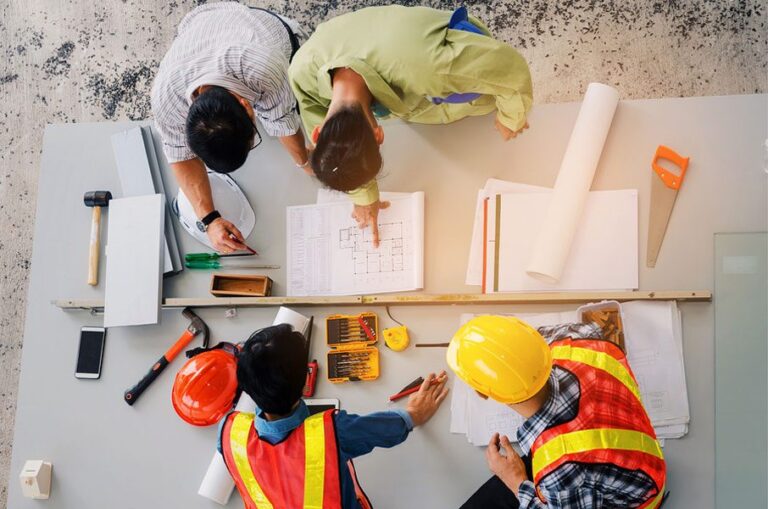Are you overwhelmed by the prospect of coordinating multiple teams for your construction project? Imagine a world where you don’t have to juggle separate designers and contractors, facing communication gaps and finger-pointing.
Welcome to the streamlined world of design-build services, where your dream project turns into reality under the guidance of one unified team. This approach is exemplified by top-rated design build contractors from San Diego, who offer a seamless and efficient process, ensuring that your project is executed flawlessly from start to finish.
What is Design-Build and How Does it Work?
Design-build is a project delivery method that breaks away from the traditional design-bid-build approach. Here’s the difference:
- Traditional Design-Bid-Build: You hire an architect or engineer to create a design and then seek bids from various contractors to execute the build based on that design. If unforeseen challenges arise during construction, this often leads to delays and potential cost overruns.
- Design-Build: A single entity, known as the design-builder, is responsible for your project’s design and construction phases. This team brings together architects, engineers, construction professionals, and other specialists under one roof, fostering a collaborative environment.
The design-builder acts as your single point of contact, streamlining communication and ensuring everyone involved is working towards the same goal: bringing your vision to life within budget and on schedule.
Why Choose Design-Build? Unveiling the Advantages
The benefits of design-build extend far beyond a simplified communication flow. Let’s delve deeper into the reasons why you might choose this approach:
- Streamlined Communication and Reduced Risk: With a single point of contact, any issues that arise can be addressed quickly and efficiently. The design-build team works together to find solutions, minimizing delays and finger-pointing that can plague traditional methods.
- Faster Project Completion: Time is money, especially in the world of construction. Design-build eliminates the need for separate bidding periods, allowing for a more fluid transition between design and construction phases. This overlap can significantly shorten project timelines, getting you into your new space sooner.
- Enhanced Budget Management: Cost control is a major concern for any construction project. With design-build, there’s a unified focus on keeping costs within budget. The design-builder is vested in optimizing project costs throughout the process, as they are responsible for both design and construction. This collaborative approach helps to identify and address potential cost overruns early on.
- Improved Quality and Innovation: The close collaboration within the design-build team fosters a culture of innovation. Designers and builders work together to find creative solutions that optimize functionality, aesthetics, and cost-effectiveness for your project. This can lead to a higher quality final product that exceeds your expectations.
The Design-Build Process: A Step-by-Step Journey
Now that you understand the core principles of design-build, let’s explore the process in more detail:
Step 1: Initial Consultation – Setting the Stage for Success
The journey begins with a comprehensive consultation. This is your opportunity to share your vision, budget, and any specific requirements you may have. The design-build team will actively listen to your needs and ask clarifying questions to understand your project goals fully. This initial dialogue lays the foundation for a successful collaboration.
Step 2: Project Design – From Vision to Blueprint
Following the consultation, the design phase kicks off. This stage involves transforming your ideas into practical and functional designs. The design-build team will utilize their expertise to create plans, blueprints, and 3D models that bring your vision to life.
This dynamic phase allows you to expect regular updates, presentations, and potentially even prototypes. This open communication allows you to visualize the result and make adjustments before construction begins.
Step 3: Construction Phase – Building Your Dream
Once the designs are finalized and approved, the project seamlessly transitions into the construction phase. Since the same team is responsible for both design and construction, there’s a clear understanding of the project goals and specifications. This streamlined approach minimizes delays and ensures a smooth transition from planning to execution.
The design-builder will manage all aspects of construction, including material procurement, subcontractor coordination, and quality control inspections. Throughout this phase, open communication remains crucial, and the design-builder will keep you informed of progress and address any concerns that may arise.
Step 4: Project Completion and Follow-Up – Ensuring Your Satisfaction
The exciting moment arrives – your project is complete! But the design-build team’s commitment doesn’t end there. During the handover process, the team will walk you through the finished project, ensuring everything functions as expected and you’re completely satisfied with the final outcome. Most design-build firms offer follow-up services to address any minor adjustments needed after some time of use.
Beyond the Basics: Unveiling Additional Benefits of Design-Build
- Reduced Risk and Increased Accountability: Because the design-builder is solely responsible for design and construction, they have a greater incentive to ensure the project’s success. This translates to a reduced risk of project failure for you, the owner.
- Single Source of Truth: Having one point of contact simplifies the process of obtaining information and resolving issues. There’s no need to chase down answers from separate designers and contractors.
- Improved Sustainability: Design-build teams can incorporate sustainable practices from the outset, considering factors like energy efficiency and eco-friendly materials selection throughout the design and construction phases.
- Enhanced constructability: With designers and builders working collaboratively from the start, potential construction challenges can be identified early on in the design phase. This allows for adjustments to be made, leading to a more efficient and cost-effective construction process.
Design-Build vs Design-Bid-Build: A Side-by-Side Comparison
To further solidify the advantages of design-build, let’s create a table comparing it with the traditional design-bid-build approach:
Is Design-Build Right for You?
While design-build offers numerous advantages, it’s not a one-size-fits-all solution. Consider these factors to determine if it’s the right approach for your project:
- Project Complexity: Design-build is well-suited for complex projects where close collaboration and innovation are crucial.
- Project Budget: If budget control is a top priority, design-build can provide greater certainty and transparency.
- Project Timeline: For projects with tight deadlines, design-build’s faster completion times can be a significant advantage.
- Your Level of Involvement: If you prefer a hands-off approach and want a single point of contact, design-build simplifies the process.
Finding the Right Design-Build Partner
Choosing the right design-build team is crucial for project success. Here are some tips for your search:
- Experience and Expertise: Look for a team with a proven track record in projects similar to yours.
- Communication Style: Ensure clear and open communication is a priority for the team.
- References: Ask for references from past clients to get a sense of the team’s work ethic and quality.
- Contractual Clarity: Have a lawyer review the contract to clearly understand roles, responsibilities, and guarantees.
By following these guidelines, you can find a design-build partner who will transform your vision into a reality, exceeding your expectations throughout the entire construction journey.

